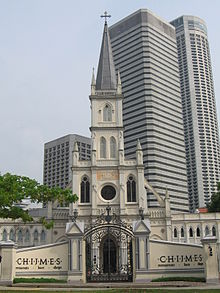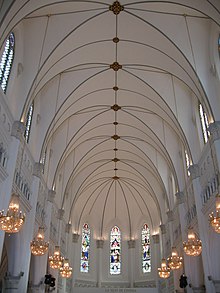Chijmes

Chijmes was originally a branch of the Sisters of the Infant Jesus , a religious order in the Roman Catholic Church in Singapore . The historic complex has meanwhile become profaned and a popular meeting place with a variety of restaurants and bars and an atmosphere similar to Covent Garden in London . Both the main building of the monastery, Caldwell House, and the monastery chapel Chijmes Hall have been declared national monuments.
The name of the complex is derived from the abbreviation CHIJ, Convent of the Holy Infant Jesus , pronounced Chijmes.
history
The story of Chijmes has its origins in Nicolas Barré , a French priest who was born in Amiens in 1621 . In his youth he was tutored by Jesuits , entered the Minimes monastery and eventually became a professor of theology .
To alleviate the plight of the poor population in France, he decided in 1662 to improve their education. With some women he founded the first free school for the poor in Rouen . As the influx increased, more schools for the poor were set up. The success of his project aroused the suspicion of conventional educational institutions. In order to break off their resistance at the top, Barré founded the community of the Sisters of the Infant Jesus in 1666 , whose sisters were supposed to work at the religious schools. In 1678 he established the novitiate of the congregation . Nicolas Barré died on May 24, 1686.
The French Revolution brought about great changes in the social and political conditions in France. Yet the congregation grew steadily. Less than 25 years after its inception, 80 schools across France offered free classes to the poor. With the papal recognition of the Congregation of the Holy Child Jesus, its expansion into America, England, Spain, Malaysia, Japan and Thailand began.
In Singapore, Jean Marie Beurel, a priest from St. Brieuc in Brittany, served in the mission from 1839 to 1869. In 1849, he recommended the then Governour Butterworth to found a monastery next to the recently completed Church of St. Joseph on Victoria Street. The governor refused, as did his successor Blundell in 1852.
However, Jean Marie Beurel did not give up: on August 18, 1852, he bought a house on the corner of Victoria Street and Bras Basah Road for $ 4,000. The house was built in 1840–1841 by the then famous architect Cdnan for Mrs. Caldwell. At the same time he wrote to the head of the sisters in France and asked for nuns to be sent to lead the monastery.
The first dispatch of five nuns in 1851 was a failure: the matron died at sea, one nun developed meningitis, and another left the order after arriving in Singapore. Only two nuns remained, so that renewed support from France was necessary.
On February 5, 1854, four more nuns from France reached Singapore after their 6-month journey and established their order there. Its leader, Matron Mathilde Raclot, would become one of the most influential figures in the early history of the Singapore congregation.
The nuns moved into quarters at Caldwell House. Spartan conditions awaited them there: a bed, two mattresses, two armchairs and two chairs were all the four found. Ten days after their arrival, the first 14 students moved into the monastery. Two classes were set up, one for paying students and one for the poor and orphans . An orphanage was also opened. In addition, the monastery served as a safe haven for persecuted women.
At that time there were fewer than 200 Europeans in Singapore, few of whom were Catholic. The construction of the monastery therefore proceeded very slowly at first. However, as the number of students increased and the monastery school became better known, another sending of religious sisters from France became necessary. In 1894, 197 students were taught in the monastery, 10 years later there were 300. A secondary school was established in 1905. Founded in 1933, the Saint Nicholas Girls' School was relocated to the monastery in 1949. In 1985 the school moved again and moved to Ang Mo Ko.
The order's first chapel was built around 1850, but was soon so dilapidated that a new building was necessary. In 1860, Father Beurel gave the order four properties between Victoria Street and North Bridge Road, which he had bought in 1840 from the Raffles Institution, which had run into financial difficulties. This created the outer dimensions of the monastery - as it is today.
Construction of the new chapel in neo-Gothic style began in 1901 and completed in 1904. Father Charles Benedict Nain , who also led the expansion of the Saint Joseph Institution , was won over as the architect . The numerous architectural details in the chapel are due to his work. The two-story galleries on both sides of the chapel were added around 1913.
The day's events in the monastery were carefully documented in diaries by the order. A total of seven books with the title Annales de Singapour describe the period from 1851 to 1971 in French. Accordingly, life in the monastery was anything but quiet. The sisters had to organize and attend the masses, teach in the school, maintain the monastery buildings and raise funds for the activities of the monastery.
In 1983 the Order shifted its activities. The last mass in the chapel was held on November 3, 1983. The monastery was then closed and, over the next 5 years, it was extensively restored for 100 million Singapore dollars and converted into an event and entertainment center. In 2002 the project received the Asia Pacific Heritage Award for Cultural Heritage Conservation from UNESCO . Both the Chijmes Hall chapel and the original monastery building, Caldwell House, were declared national monuments by the Singapore government on October 26, 1990.
The monastery complex with its cobbled paths, inner courtyards and small gardens is a place of calm within the fast-paced city of Singapore, despite the restaurants and bars that have now moved into its walls. In addition to culinary attractions, art and craft products are on offer, and there is an art gallery in Caldwell Hall moved in. The entire complex is often used as a picturesque backdrop for musicals, theater performances, concerts, fashion shows, etc. The historic chapel is a place for weddings.
swell
- Information on Father Nicholas Barré ( Memento of December 28, 2009 in the Internet Archive )
- Page of the Infant Jesus Sisters ( Memento from September 12, 2008 in the Internet Archive )
- Dorling Kindersley Eyewitness Travel Guides: Singapore, 2003, ISBN 0-7513-6999-3
- National Heritage Board (2002), Singapore's 100 Historic Places , Archipelago Press, ISBN 981-4068-23-3
- Norman Edwards, Peter Keys (1996), Singapore - A Guide to Buildings, Streets, Places , Times Books International, ISBN 9971-65-231-5
- Preservation of Monuments Board, Know Our Monuments
Web links
Coordinates: 1 ° 17 ′ 42.6 ″ N , 103 ° 51 ′ 8 ″ E




